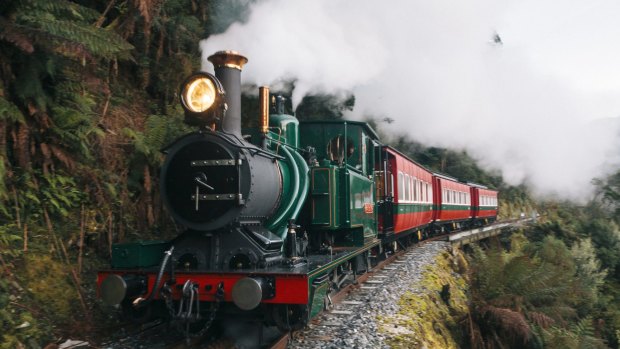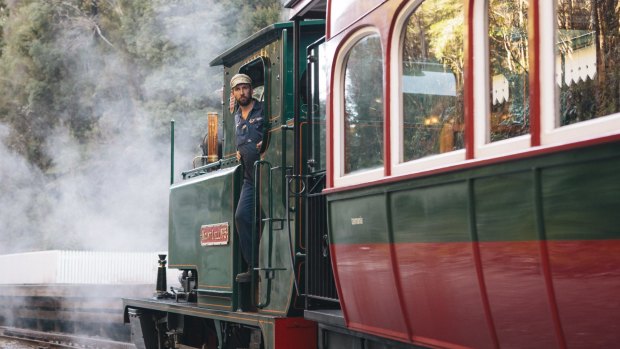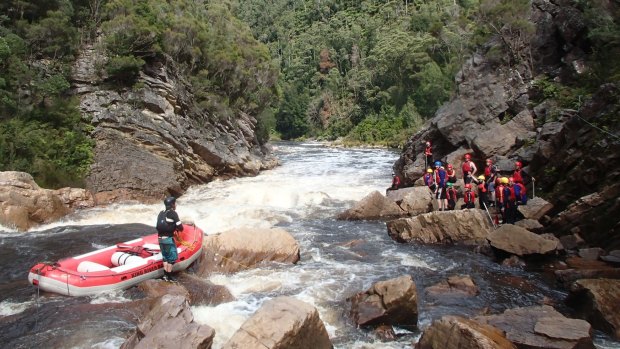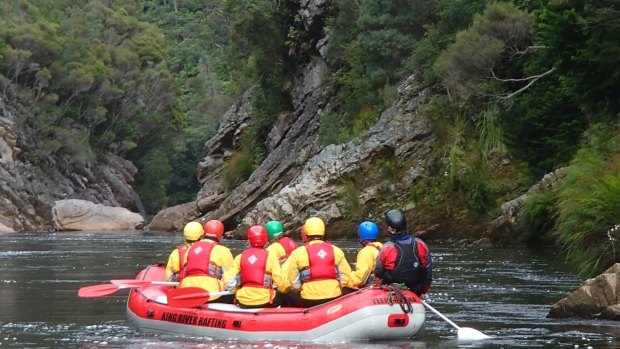This was published 6 years ago
West Coast Wilderness Railway, Tasmania: Not your average ride on a steam train
By Andrew Bain

The West Coast Wilderness Railway steams ahead. Credit: Nick Osborne
It's a train journey of almost Edwardian gentility. The rail carriages jolt through the rainforest at little more than the pace of a morning jog, and passengers sit cosy beneath warming blankets with thermoses readied for tea beside them.
But not everything on Tasmania's West Coast Wilderness Railway has to be gentle. On this historic steam train between Queenstown and Strahan, a line built in the late 19th century to transport Queenstown's enormous copper lode to the world, there are exciting ways to go off the rails. Days that begin on the train can end in a helicopter, and days that finish on the train can start on wild river rapids.
For me, it's a journey that begins in Strahan, at the Wilderness Railway's station on Regatta Point, where old pylons angle out of Macquarie Harbour like teeth, and the locomotive seems to hover on a cloud of steam.

Thehistoric steam train between Queenstown and Strahan was built in the late 19th century to transport Queenstown's enormous copper lode to the world.
Though the railway stretches for 35 kilometres through some of the most tangled land in Tasmania, I will be on it for just 20 kilometres, heading inland along the banks of the King River.
To reach the river, the train follows the coast of Macquarie Harbour, a body of water six times the size of Sydney Harbour, its surface crisscrossed by tourist boats heading for the Gordon River.
At Lowana, by the mouth of the river, the railway leaves the bay and turns inland, entering the rainforest that so defines Tasmania's west coast. For a time the train runs hard against the river edge, where the tannin-stained waters are like tinted glass. Huon pines droop over the river, and the railway cuttings are coated in moss as thick as crash pads.

King River Rafting.
One glimpse at the rainforest on the opposite bank is enough to appreciate some of the difficulty of the railway's construction. When surveyors tried to tell the train's instigator, Mt Lyell Mining founder Bowes Kelly, that it was impossible terrain for a railway, he fired them, adopting instead a motto of "Labor Omni Vincit" ("We find a way or make a way"). And so the line was carved across some of the steepest rail grades in the world.
Signs of the intense industry that drove the railway are few, but evocative. An iron bridge, shipped to the King River in module-like pieces from England, straddles the river, and a small railway station amid the dense rainforest is all that remains of the once-busy settlement of Teepookana. In its day this riverside location was the fourth-largest port in Tassie, home to a two-storey pub and about 200 people. But forest this rampant quickly erases human effort, and barely a hint of the activity remains.
At the next station, the rhythmically named Dubbil Barril, in the literal middle of nowhere, I leave the train. Within minutes, the ratchety sound of a helicopter fills the valley. My ride back to Strahan has arrived.

King River rafting in Tasmania.
Combination train and helicopter journeys were launched at the start of this year in conjunction with Strahan Helicopters, providing the chance to gain a larger perspective on the terrain and waterways that are the railway's guiding lines.
From a grassy clearing below the station, the helicopter banks out over the King River, climbing above the gorge that presented the railway's builders with their greatest challenge.
Instead of turning immediately for Strahan, we fly upstream. The river below runs fast and full, its dark water replaced by white-water inside the gorge as rapids jostle between the cliffs. Soon there's the surreal sight of the Queen River pouring into the King River in the most distinct of confluences: the stout-black King River and the unnaturally orange waters of the Queen River, which flows down through Queenstown and the mines.
"They call it Pumpkin Soup River," pilot Matt tells me. "Apparently around 100 million tonnes of copper tailings have gone down that river over the life of the mines."
In the helicopter we rise up and over Queenstown and the deep wound of the Mt Lyell mine. For an area that's made its reputation as a moonscape, there's a surprising cover of trees in the rejuvenating landscape.
As we swing back west over Lake Burbury and the Crotty Dam, where the King River begins, there's a glimpse north of Cradle Mountain. Corrugations of wind shudder off the slopes of Mt Jukes, shaking us as we follow the line of the King River back to Strahan, the train now visible below as it grinds its way up the slopes above the King River Gorge.
The next morning I will complete my rail journey to Queenstown, but not as simply as by just boarding the train. First, I will experience the King River in the most intimate and committing way possible – rafting it.
The most adventurous extension to a train ride on the West Coast Wilderness Railway is its Raft and Steam Experience, with King River Rafting hurtling you through the gorge before you return to Queenstown from Dubbil Barril on the train.
We take to the water at the head of the gorge, just a few metres downstream from the John Butters Power Station, where we float for a moment in an eddy before the current sucks us beneath a road bridge and into the wilderness.
Ahead is a seven-kilometre journey through the gorge, bumping and swirling through a succession of rapids. In the raft with me are Wayne and his teenage grandsons Sam and Will. Wayne's eyes are so full of the beauty of the river and rainforest that he continually forgets to paddle. Calls of "paddle forward, grandpa" become the soundtrack of our morning.
Within minutes of setting out, we come to the confluence of the King and Queen rivers, our rafts suddenly like three croutons in the pumpkin soup as we pause a few metres upstream in the Queen.
"Do you want a gentle ride, or thrills and spills?" King River Rafting guide and owner Paul ask.
"Thrills and spills," Wayne says without hesitation, so that at the bottom of the next rapid Paul turns the raft, reversing it into the white-water, which pours over us, filling the raft with water. One moment Will is sitting on the raft's edge, the next he is gone, washed overboard. He floats downstream like debris, where he's scooped up, grinning madly, by one of the other rafts.
At times through the gorge, we stop paddling and simply float, carried effortlessly downstream. At other times, we're bouncing off rocks and dipping and splashing through rapids. A Huon pine – one of many along the river – grows staunchly from a rock in the middle of the water, while the twisted rock of the cliffs and the molasses-black water are reminiscent of the famed Franklin River, just 20 kilometres to the east.
"We call it the Franklin in a day," Paul says. "You've got the gorge, flat water and rapids."
At a furious rapid named Sailor Jack, the railway comes into view as an ambitious slash across a precipitous, densely forested slope. It's our final rapid and the most powerful, requiring us to portage it rather than run it. As the guides throw the rafts through the rapid, we climb steeply up then down the cliffs, aided by wooden blocks bolted to the rock.
As we climb back into the rafts, the train itself is now peering down at us, stopped on the tracks to watch our progress. Together we glide on to Dubbil Barril.
It's a reunion of sorts, for here I board the train to complete my trip to Queenstown. It's here at Dubbil Barril that the marvel of this railway becomes most apparent, with the presence of the King River Gorge forcing the line up and over the mountains at Rinadeena Saddle, using a rack-and-pinion line.
As we begin out of Dubbil Barril, we're climbing on the second-steepest railway incline in the southern hemisphere...beaten only by the descent on the other side of Rinadeena Saddle.
I settle into my seat in the timber-lined carriage. I'm ready for my tea and blanket.
Andrew Bain travelled as a guest of West Coast Wilderness Railway, Strahan Helicopters and King River Rafting.
See also: 10 of Australia's most spectacular natural wonders are all in our smallest state
See also: Tasmania's ancient railway line runs again
FIVE OTHER STEAM TRAINS
PUFFING BILLY (VICTORIA)
The big smoke of Australian steam railways, chugging 24 kilometres from Belgrave to Gembrook.
JACOBITE (SCOTLAND)
The only steam service on the UK's national timetable network, travelling more than 60 kilometres from the foot of Ben Nevis to Mallaig. Along the way it crosses Glenfinnan Viaduct, made famous in the Harry Potter movies.
SNOWDON MOUNTAIN RAILWAY (WALES)
Steam your way to the top of Wales' highest mountain on the UK's highest railway.
HARZ RAILWAY (GERMANY)
A network of three lines, covering 140 kilometres through Germany's Harz Mountains.
DARJEELING HIMALAYAN RAILWAY (INDIA)
The famed Toy Train, climbing around 2000 metres from near Kolkata to the hill station of Darjeeling.
TRIP NOTES
MORE
FLY
Virgin Australia flies direct to Launceston, from where it's around a four-hour drive to Queenstown. See virginaustralia.com
STAY
Complete the mine connection by staying at Queenstown's Penghana Bed & Breakfast, the National Trust-listed former mine manager's home, perched on a rise overlooking the town. See penghana.com.au
TRAVEL
The West Coast Wilderness Railway runs daily between Queenstown and Strahan. The Heli-Steam package costs from $299 per person, with the Raft and Steam Experience costing $300).
Sign up for the Traveller Deals newsletter
Get exclusive travel deals delivered straight to your inbox. Sign up now.